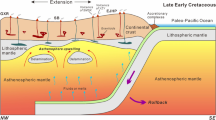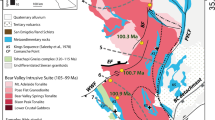Abstract
The Onega plateau constitutes part of a vast continental flood basalt province in the SE Baltic Shield. It consists of Jatulian-Ludikovian submarine volcanic, volcaniclastic and sedimentary sequences attaining in places 4.5 km in thickness. The parental magmas of the lavas contained ∼10% MgO and were derived from melts generated in the garnet stability field at depths 80–100 km. The Sm-Nd mineral and Pb-Pb whole-rock isochron ages of 1975 ± 24 and 1980 ± 57 Ma for the upper part of the plateau and a SHRIMP U-Pb zircon age of 1976 ± 9 Ma for its lower part imply the formation of the entire sequence within a short time span. These ages coincide with those of picrites in the Pechenga-Imandra belt (the Kola Peninsula) and komatiites and basalts in the Karasjok-Kittilä belt (Norway and Finnmark). Together with lithostratigraphic, chemical and isotope evidence, these ages suggest the derivation of the three provinces from a single large (∼2000 km in diameter) mantle plume. These plume-generated magmas covered ∼600,000 km2 of the Baltic Shield and represent a major contribution of juvenile material to the existing continental crust at 2.0 Ga. The uppermost Onega plateau lavas have high (Nb/Th)N = 1.4–2.4, (Nb/La)N= 1.1–1.3, positive ɛNd(T) of +3.2 and unradiogenic Pb-isotope composition (μ1 = 8.57), comparable with those of modern oceanic plume-derived magmas (oceanic flood basalt and ocean island basalt). These parameters are regarded as source characteristics. The lower sequences have (Nb/Th)N= 0.58–1.2, (Nb/La)N= 0.52–0.88 and ɛNd(T) =−2.6. They have experienced mixing with 10–30% of continental crust and resemble contaminated lavas from other continental flood basalt provinces. The estimated Nb/U ratios of 53 ± 4 in the uncontaminated rocks are similar to those found in the modern mantle (∼47) suggesting that by 2.0 Ga a volume of continental crust similar to the present-day value already existed.
Similar content being viewed by others
Author information
Authors and Affiliations
Additional information
Received: 17 June 1997 / Accepted: 24 September 1997
Rights and permissions
About this article
Cite this article
Puchtel, I., Arndt, N., Hofmann, A. et al. Petrology of mafic lavas within the Onega plateau, central Karelia: evidence for 2.0 Ga plume-related continental crustal growth in the Baltic Shield. Contrib Mineral Petrol 130, 134–153 (1998). https://doi.org/10.1007/s004100050355
Issue Date:
DOI: https://doi.org/10.1007/s004100050355




